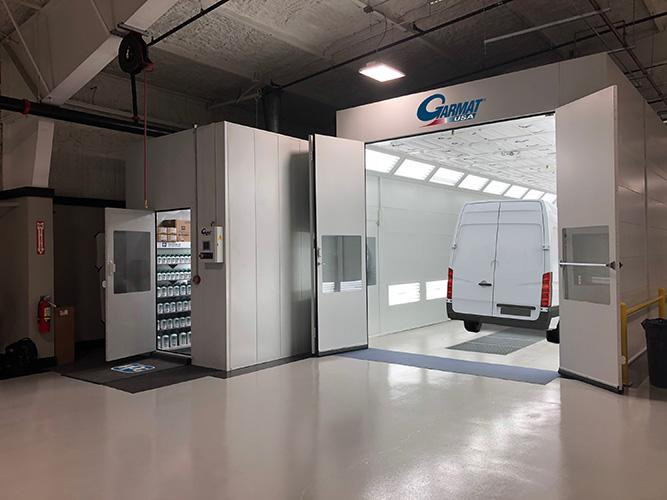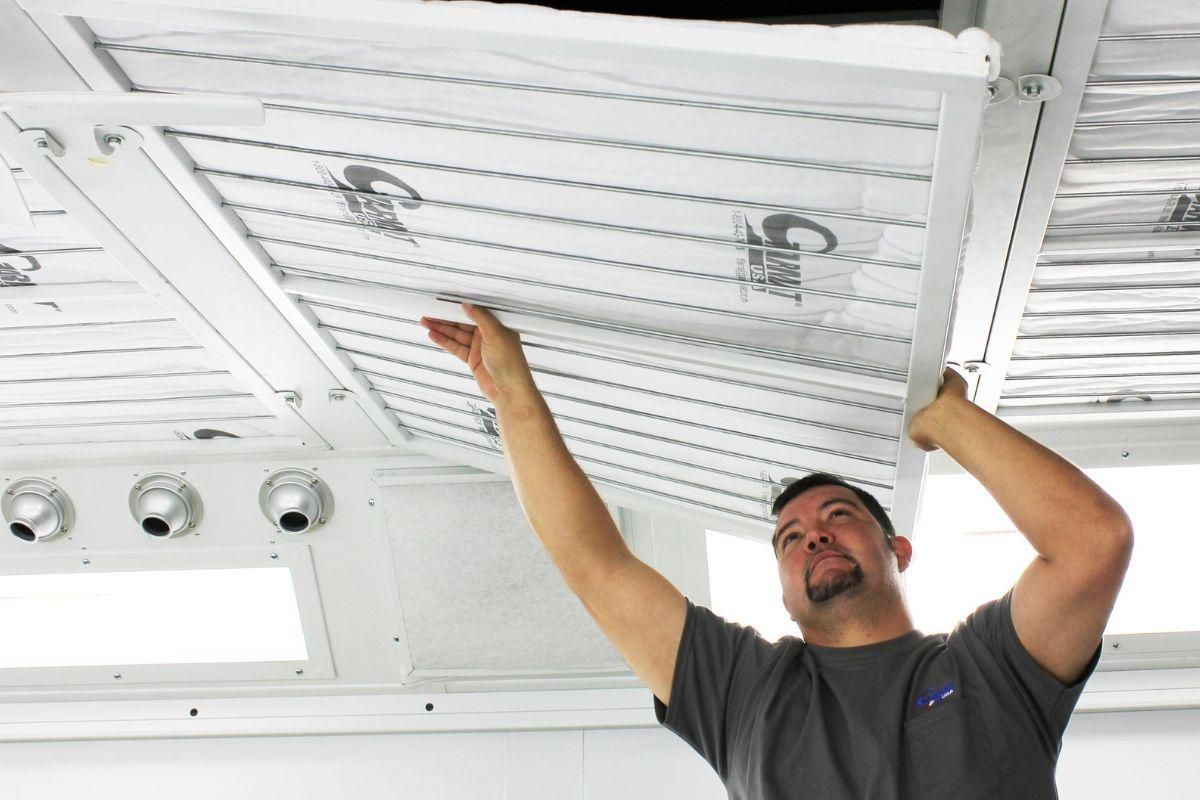The paint booth is one of the most critical aspects of a collision repair shop’s performance, but contamination -- from the vehicle, the painter or in the booth itself -- can lead to costly re-dos, eating into a shop’s bottom line from multiple directions.
Rick Selover, national account manager with Garmat USA, appeared on The Collision Vision podcast, driven by Autobody News and hosted by Cole Strandberg, to talk about the main sources of contamination, solutions to reduce cost and best practices for maintaining paint booths to maximize their performance.
Selover has more than 40 years in the industry, starting as a technician, during which time he painted both in booths and on open floors. He later moved into paint material distribution. Recently, he joined Garmat USA.
He built a presentation on the “cost of contamination,” based on his experience with the issues dirt and other contaminants can cause when refinishing a vehicle, and how to minimize them.
“I dive really deep into the costs of contamination, because I don't think most shops really realize how much it does cost them,” Selover said.
Selover said he got input from manufacturers, distributors, paint and material distributors, paint company reps and collision repair instructors to identify the three root causes of contamination.
“It's either the booth, it's the vehicle, or it's the painter,” he said. “All three of those have multiple issues that may be tied back to them as the root source.”
However, the painter can mitigate any dirt brought in by the vehicle before it goes into the booth, Selover pointed out.
“It really boils down to the booth and the vehicle, and it's almost a 50/50 split, but…a painter can prevent a lot of his own problems,” Selover said.
The paint itself arrives clean, as do spray guns and paint booths, he said. “But sometimes between when everything's brand new and you actually get that vehicle in the booth, pull the trigger, you're bringing in some dirt as a painter.”
Slacking on maintenance makes it difficult to get a clean job.
Selover said he has heard from many shop owners who can’t figure out why their paint material bill is so high, or why their refinishes always “come out looking like crap.”
Most shop owners notice when a monthly statement shows an extra $4,500 spend on paint, but they don’t see the hidden costs of re-dos.
There are four cost components to a re-do: materials the shop wasn’t able to sell because it had to use them to repaint a vehicle; energy to run the equipment; production, as a re-do “chews up” a paint booth cycle at an average cost of $4,300; and retention, when a painter eventually leaves for another shop because they’re also losing money on too many re-dos.
“Most painters don't realize how much they're losing every time they have to re-do a job. Well, I've got those numbers too, and I think they'd be shocked,” Selover said.
The poor first finish could be the fault of a shop owner not keeping up with maintenance on air filters, for example, or it could be the painter’s fault: “Maybe they didn't throw a suit on. Maybe they sanded a job between coats, maybe they’ve got five parts racks full of garbage and stuff in their booth that they work around,” Selover said “There's a million factors to this.”
No matter whose fault it is, the money lost to re-dos could pay for a lot of preventative maintenance or new equipment that would prevent them going forward, Selover said.
“I think the sooner shops get an understanding of what's at stake here, they may react a little bit differently than they have in the past,” he added.
Collision Repair Paint Booth Maintenance
Maintaining a paint booth isn’t difficult, Selover said, if a shop buys the booth from a distributor that offers service.
He recommended purchasing from a distributor that will perform regular inspections of components like filters, control panels, pulleys and fans; change filters when necessary and supply more if they need to be changed between visits. He said the distributor should also keep a log of inspections and maintenance actions needed.
Garmat does an annual “deep clean” for its customers, Selover said.
“They pull everything out. They power wash the floor, the grates, the walls. They clean the lights out. They go through all the mechanicals. You get a fully clean, feels-like-new booth,” he said.
Selover said a lot of shops don't want to spend the money on preventative maintenance because it looks like a cost. “It's like, ‘Well it's working fine. Everything's coming out OK. I don't really need to do that right yet.’ They're wrong.
“They need to stay on it because if you have a consistent preventive maintenance program, you're not going to have those big costs of a motor going, of a fan sparking and catching fire,” he said. “There's so much stuff that can go wrong inside of a booth. But it's quite simply having somebody other than your painter, other than your maintenance guy or other than your shop floor porter go in there.”
Anyone who owns a high-end car would never skimp on maintenance by taking it to a mechanic offering cheap oil changes, Selover pointed out. Shop owners should treat their paint booths -- which can cost up to $200,000 and generate revenue -- the same.
“But yet I've seen shops just totally ignore [paint booth] maintenance because it's a cost they don't really need to do,” he said.
Maintenance helps with retention, he reiterated. If a painter makes good money but has to do all the upkeep on his booth, he might be more likely to accept an offer from another shop that would pay the same but has a newer booth that is maintained by the distributor.
“I was a painter before. I know what they go through. I know the stress. I know the upset when you’ve got to re-do something,” Selover said. “I didn't realize the cost. Now, looking back at the cost, I wasted a lot of money back then.”
Painter Strategies to Reduce Contamination
Selover recommended establishing strong SOPs for the paint department, including a pre-paint checklist that will “help the painters help themselves” by eliminating all potential contaminants they might bring into the booth.
“That means blowing yourself off; having a clean paint suit on; having good head protection like a sock or a full-faced, fresh air mask; gloves -- don't go in there with your bare hands,” he said.
Personal care items like hair gel and spray, beard cream and hand lotion can also bring contamination into the booth.
“You can create fish eyes just with what you put on your own body that day,” Selover said. “There's been tons of studies done that ended up finding deodorant can mitigate its way right through your clothes, through your suit, and still end up causing fish eyes.”
The booth itself should also be empty of anything not needed to repaint a vehicle.
“There should be nothing in a booth but your tack rag and your spray gun and the vehicle, or parts rack. That's it,” Selover said.
“I've seen incredible results from someone that takes the time to prepare themselves, prepare the vehicle. You get an almost flawless job,” he said “There's always going to be a little something, but a quick nub is nothing like having to re-do because you got nasty, gnarly chunks of crap blown out of your gun into the base coat, clear coat.”
Considerations When Buying a Paint Booth
Never choose a booth on cost alone, Selover said. Think about production goals, whether opening a new shop or upgrading an existing one, and choose a booth that has the capacity to meet them.
 If a shop expects to work on tall vehicles like a Sprinter van, it should take that into consideration when choosing a paint booth.
If a shop expects to work on tall vehicles like a Sprinter van, it should take that into consideration when choosing a paint booth.
Think about the shop’s potential business mix as well.
“So if you're just doing regular vehicles right now, but you see yourself getting into doing more of these Sprinter vans, well then a normal height booth is not going to work. You're going to need a high-top type of booth, which I've seen a lot of those go in,” Selover said.
“Prepare for growth. Pay ahead for the growth now. Because once you put a booth in, it's a lot of work to pull one out and put a different one,” he added.
Finally, think about where in the shop the booth should be installed to enhance, rather than inhibit, workflow. For instance, don’t put one in a corner that requires a vehicle to be backed out.
“That means, ‘I get so much more production space for my body guys,’” Selover said of the logic behind that placement. “I hope they don't mind moving all those cars out every time we have to take one out of the booth to get another one in. I've seen that a million times.”
He recommended getting input from the shop’s paint company and material distributor, as well as its booth distributor.
Also consider the booth manufacturer’s country of origin, Selover advised. If replacement parts have to come from overseas, the wait could hurt production while the booth is out of commission.
Innovation in Collision Repair Paint Booths
Strandberg asked about new technology in paint booths.
“It's a box that moves air and provides heat. There's only so much you can do with that, right?” Selover said.
However, he said, new booths are more efficient than ever, and installing lights horizontally, rather than vertically, reduces shadows.
Garmat is currently testing in about 50 shops a new piece of connected equipment that can monitor the booth, to keep track of preventative maintenance and remotely diagnose issues “before it becomes a problem.” The equipment was on display at the 2024 SEMA Show in November.
Selover wrapped up the discussion by reminding listeners he also has a bi-weekly podcast, Mind Wrench, available on Apple, Spotify, iHeart and Amazon Music.














Abby Andrews